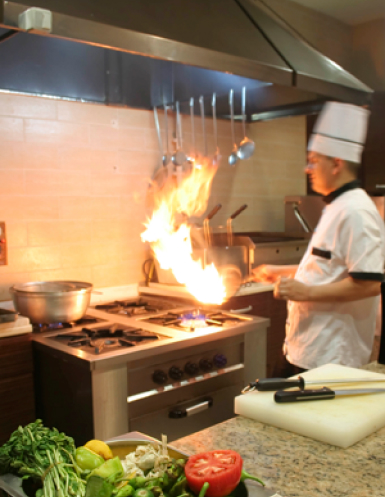

At over a million foodservice establishments across the United States and Canada, the first thing staff turn on after the lights is the commercial kitchen ventilation system. The hoods, fans, and other parts of the ventilation system remove the smoke and heat of cooking from the building and bring in fresh air. Like adequate lighting, ventilation systems are integral to safe and comfortable commercial kitchen operation. And just like the lights, the commercial kitchen ventilation system is on from opening to closing.
But sometimes there's not a lot of cooking going on between meal times. Just as you can turn down the lights to save energy when the sun lights up a room, you can turn down the ventilation system when you're not cooking at full capacity. That's demand control kitchen ventilation (DCKV)—matching system operation to what's cooking.
Case studies have shown up to 70 percent energy savings with demand control ventilation, yet less than one percent of ventilation systems have demand control.
CEE members and manufacturers are working together to improve market penetration of demand control kitchen ventilation. We're gathering a credible, compelling body of evidence demonstrating the energy savings from DCKV across several market segments and product offerings. Together, we are revealing to customers, regulators, and other stakeholders that commercial DCKV can be a solid investment. We invite you to run a field test or view the results from the first field test.
By collecting test results from demand control kitchen ventilation (DCKV) installations across multiple foodservice applications, climates, and system types, program administrators and manufacturers are demonstrating to customers, regulators, and other stakeholders the benefits of using demand control for commercial kitchen ventilation. Together we can provide decision makers a powerful dataset.
No one program administrator, manufacturer, or stakeholder can gather all this data alone. Join us.
If your organization is a member of CEE, you can find more information and work with the CEE Commercial Kitchen Committee on the CEE Forum.

–Bruce Lukens, General Manager, Gaylord Industries
it's important to understand how it's worked for others and in what conditions. Over time we expect to collect field test reports demonstrating field performance across several market segments, climate zones, and demand control kitchen ventilation (DCKV) system types.
Here’s a glimpse of what DCKV did for a full-service restaurant in Oregon.
Restaurant Name: Shari’s Café and Pies
Market Segment: Full Service Restaurant
Location: Milwaukee, Oregon
Demand control kitchen ventilation system manufacturer: Gaylord
Industries
Annual fan energy savings from adding DCKV: 30%, 10,000 kWh, $800*
Annual heating savings from adding DCKV: 11%, 1100 therms, $1,000** Learn more about this field test
*Dollar savings are based on 8.3 cents per kWh, the average annual price of electricity in Oregon in 2012 for commercial customers. (Source)
**Dollar savings are based on $9.60 per 1000 cubic feet of natural gas, the average annual price of natural gas in Oregon in 2011 for commercial customers. (Source)

–Brian Hale, General Manager,Shari’s Café and Pies
Demonstrating savings from commercial demand control kitchen ventilation systems (DCKV) gives customers a strong rationale for upgrading to a new system or installing a better system in new construction. Contributing to this effort helps build the market for DCKV systems.
Organizations with demonstrated experience conducting similar field tests and an understanding of commercial demand control kitchen ventilation systems (DCKV) can conduct field tests. Tests conducted by independent third-party organizations are preferred. Tests conducted by manufacturers are acceptable.
Please contact CEE if you are interested in conducting field tests. We can help you get started by matching you with field testing partners.
CEE has developed a Field Test Protocol that outlines how testing organizations should conduct field tests. When a new field test report is received, CEE members with expertise in commercial demand control kitchen ventilation (DCKV) systems or in field testing review the submission for adherence to the CEE Field Test Protocol. If at any time participants raise concerns, CEE would investigate, and, based on the results of the investigation, develop an appropriate plan.
We are looking for about 50 tests at a minimum, with at least six field tests per available demand control kitchen ventilation model, two tests in each of three different market segments. Across all systems combined, we seek three field tests from each of the five major climate zones defined in the test protocol.